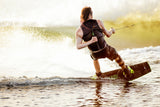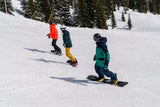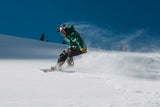Backcountry Safety
For skiers and snowboarders, there may not be anything better than the feeling of weightlessness as they glide through a mountain untracked powder. It’s surreal, invigorating, intense, yet somehow quiet and tranquil. Some can only describe the feeling as “freakin awesome”.
That feeling is the reason so many people across the world are attracted to the backcountry. Every year, as many as 701,000 skiers and snowboards in the US take their skills to out-of-bounds regions in pursuit of the perfect line. That’s not to say it isn’t risky.
If you were to ask any experienced backcountry traveler what the biggest risk in the sport is, they’d probably tell you: “Avalanches”. Avalanches pose a very real threat to all out-of-bounds travelers, at all skill and ability levels, and in any conditions. As conditions change, risk levels fluctuate. In certain conditions on certain slopes, the risk may be small. However, it is not infrequent that conditions add up to extreme risks of natural and human caused avalanches.
Whether you are hiking to your run, taking a snow cat on an out-of-bounds expedition, or jumping out of a helicopter on a bluebird day, you must understand your risks and take the necessary steps to staying safe and prepared.
Always Know Before You Go. Never Go Alone.
Get educated.
There are many resources to help you learn about assessing conditions and staying safe in the backcountry. In the backcountry, decisions have to be made in a split second. It is better to have foundational knowledge to help you make the right choices, so take at least one training course before you begin exploring the slopes in your favorite range. Avalanche.org is one of the leaders in publishing up-to-date condition reports, statistics, research papers, and training material. Also, their partnership with the American Avalanche Association (A3) and the US Forest Service National Avalanche Center (NAC) helps to connect many skiers and boarders to the training and skills they need to have. Definitely keep these guys book marked if you are serious about heading into the backcountry.
Have the right gear.
Skills and instinct are only half the story here. If you do end up in the worst case scenario, it is important to be prepared with reliable tools you may need to get yourself, or someone else, back to safety and possibly even save a life. These are the essentials:
- Beacon - These small electronics send and receive powerful signals capable of traveling through snowpack. They will make you searchable in the event that you are buried, as well as help pin point a general location of a buried person. Beacons can sometimes be complicated to use, so be sure that you practice using this before you go out-of-bounds. Shop Ski Pro for Beacons.
- Probe - An avalanche probe is best tool for pin-pointing a buried persons exact location under the snow. A probe is super lightweight and very portable, constructed much like a tent pole. With proper technique, a probe can be one of the most efficient way to narrow down your search. Shop Ski Pro for Probes.
- Shovel - Once you have determined your buried persons location, you’ll have to dig them out. This is where an avalanche shovel comes in. This will likely be the largest piece of equipment in your kit. Many shovels can be broken down into smaller pieces and are made of super light but strong alloys and plastics. Shovels are also useful for snow studies and building features. It is absolutely worth the investment to get a durable and easy to use shovel for backcountry travel. Shop Ski Pro for Shovels.
- Airbag - A relatively new piece of safety equipment, an airbag can be a gamechanger for avalanche survival rates. Larger volume objects tend to rise to the surface during an avalanche event. Airbags help by raising your total volume up to 150 liters, therefor lowering your chances of getting completely buried. Shop Ski Pro for Airbags.
- Backpack - You’ll need something to pack all this gear into, as well as some extra layers, food, water, and whatever else you need for your trip. Pick a high-quality pack that will last a lifetime. Many backpacks on the market have integrated avalanche tool pockets and even integrated airbag systems. Shop Ski Pro for Backpacks.
Bring some friends, and make a plan.
Always have a plan in place for your backcountry excursions. A solid plan will help you and your friends have a safe expedition and will generally be more rewarding once the day is done. Consider all the variables and have a solution to any possibility. Be sure to bring a team of friends to tour with you and make memories with. And always make sure someone at home knows what your plans are and when to expect your return.
Continue learning about touring and backcountry skiing at these resources:
https://utahavalanchecenter.org/
https://www.sierraavalanchecenter.org/













